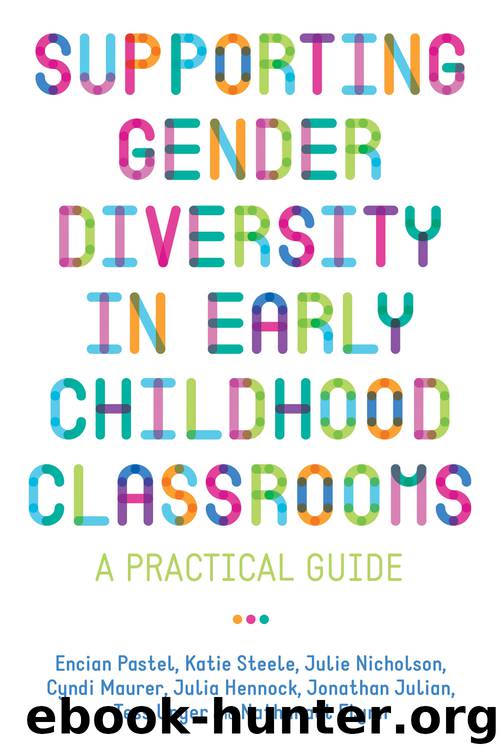Supporting Gender Diversity in Early Childhood Classrooms by Julie Nicholson

Author:Julie Nicholson
Language: eng
Format: epub
ISBN: 9781784509149
Publisher: Jessica Kingsley Publishers
Published: 2019-09-15T16:00:00+00:00
Be kind to yourself: your journey to gender justice will take you through different stages of building awareness and learning
One who knows not and knows not that they knows not is a fool; avoid them.
One who knows not and knows that they knows not is a student; teach them.
One who knows and knows not that they know is asleep; wake them.
One who knows and knows that they know is a wise person; follow them.
–Ancient proverb of multiple origins, adapted to be gender neutral
In 1969, Martin M. Broadwell described the path to becoming a good teacher as the “four levels of teaching” to show how teaching is a skill that can be developed and strengthened. These four levels were refined in 1974 by Noel Burch and described as the “four stages of learning any new skill.” As we embark on any new learning journey, we will pass through at least some of these stages, and indeed the beginning of learning often signifies the beginning of Stage 2.
The first stage is “unconscious incompetence” in which we do not know what we do not know. We may be entirely unaware that there is a skill to learn, or we may inaccurately believe ourselves to be more competent than we are, but in the first stage we are not consciously aware of our deficit. For example:
• You might be misgendering a child without even knowing you are doing so.
• You might believe you “do not see gender” and that you treat all children the same, but your actions are subconsciously guided by assumptions and biases.
• You might have all the right intentions but be unaware that intention is typically not enough to create safety and justice for TGE children.
• You might not apply a “gender justice” lens to decision-making—“Oh, I love these new fairy figurines! I’ll buy them for my class this year.”—but not notice they are all female-coded with breasts and lipstick and long hair).
The second begins when we become aware of our lack of skill in an area. This is “conscious incompetence.” In this stage we are willing to admit that we have learning to do. We make lots of mistakes, but we see it happening and can learn from them. Someone in Stage 2 might actively seek out help and resources to improve. In fact, there’s a good chance you are in Stage 2 of learning about gender in early childhood just because you’ve picked up this book! However, maybe as you read you will discover some areas where you are still in Stage 1 or where you are already in Stage 3 or 4. During Stage 2, we work hard to practice and learn. We are conscious of our growth, and we put in a lot of effort to improve.
• Many teachers are tossed head first into Stage 2 when a transgender child joins their program or a child already in their care communicates that they are not the gender they were assigned. Teachers in this situation often want to support the child but realize they have no idea how.
Download
This site does not store any files on its server. We only index and link to content provided by other sites. Please contact the content providers to delete copyright contents if any and email us, we'll remove relevant links or contents immediately.
| Administration | Assessment |
| Educational Psychology | Experimental Methods |
| History | Language Experience Approach |
| Philosophy & Social Aspects | Reform & Policy |
| Research |
The Art of Coaching Workbook by Elena Aguilar(48063)
Trainspotting by Irvine Welsh(20055)
Twilight of the Idols With the Antichrist and Ecce Homo by Friedrich Nietzsche(17705)
Fangirl by Rainbow Rowell(7833)
Periodization Training for Sports by Tudor Bompa(7328)
Change Your Questions, Change Your Life by Marilee Adams(6641)
This Is How You Lose Her by Junot Diaz(5771)
Grit by Angela Duckworth(4736)
Red Sparrow by Jason Matthews(4665)
Asking the Right Questions: A Guide to Critical Thinking by M. Neil Browne & Stuart M. Keeley(4574)
Paper Towns by Green John(4169)
Room 212 by Kate Stewart(4107)
Ken Follett - World without end by Ken Follett(3972)
The Sports Rules Book by Human Kinetics(3588)
Housekeeping by Marilynne Robinson(3401)
The Motorcycle Diaries by Ernesto Che Guevara(3332)
Introduction to Kinesiology by Shirl J. Hoffman(3299)
Exercise Technique Manual for Resistance Training by National Strength & Conditioning Association(3291)
Double Down (Diary of a Wimpy Kid Book 11) by Jeff Kinney(3272)
